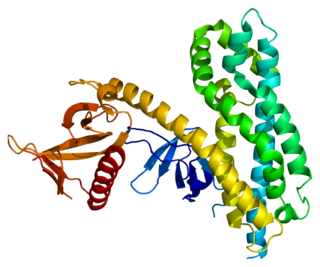
5'-AMP-activated protein kinase subunit beta-1 is an enzyme that in humans is encoded by the PRKAB1 gene.

24-Dehydrocholesterol reductase is a protein that in humans is encoded by the DHCR24 gene.

Dual specificity protein phosphatase 3 is an enzyme that in humans is encoded by the DUSP3 gene.

Leucine-rich repeats and immunoglobulin-like domains protein 1 is a protein that in humans is encoded by the LRIG1 gene. It encodes a transmembrane protein that has been shown to interact with receptor tyrosine kinases of the EGFR family and with MET and RET.

WW domain-binding protein 2 is a protein that in humans is encoded by the WBP2 gene.

Elongation factor G 1, mitochondrial is a protein that in humans is encoded by the GFM1 gene. It is an EF-G homolog.

Cytochrome b561 is a protein that in humans is encoded by the CYB561 gene.

DEAD (Asp-Glu-Ala-Asp) box polypeptide 27, also known as DDX27, is a human gene.

ATPase inhibitor, mitochondrial is an enzyme that in humans is encoded by the ATPIF1 gene.

Putative Polycomb group protein ASXL1 is a protein that in humans is encoded by the ASXL1 gene.

N-terminal EF-hand calcium-binding protein 2 is a protein that in humans is encoded by the NECAB2 gene.

Pseudouridylate synthase 7 homolog-like protein is an enzyme that in humans is encoded by the PUS7L gene.

SET and MYND domain-containing protein 4 is a protein that in humans is encoded by the SMYD4 gene.

Deoxyribonuclease-1-like 2 is an enzyme that in humans is encoded by the DNASE1L2 gene.

Ninein-like protein is a protein that in humans is encoded by the NINL gene. It is part of the centrosome.

Rho guanine nucleotide exchange factor 4 is a protein that in humans is encoded by the ARHGEF4 gene.

DCC-interacting protein 13-beta is a protein that in humans is encoded by the APPL2 gene.

Twinfilin-1 is a protein that in humans is encoded by the TWF1 gene. This gene encodes twinfilin, an actin monomer-binding protein conserved from yeast to mammals. Studies of the mouse counterpart suggest that this protein may be an actin monomer-binding protein, and its localization to cortical G-actin-rich structures may be regulated by the small GTPase RAC1.

SLX4 is a protein involved in DNA repair, where it has important roles in the final steps of homologous recombination. Mutations in the gene are associated with the disease Fanconi anemia.

Ubiquinone biosynthesis protein COQ9, mitochondrial, also known as coenzyme Q9 homolog (COQ9), is a protein that in humans is encoded by the COQ9 gene.













